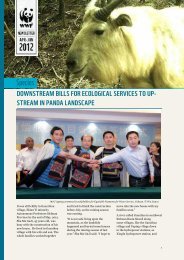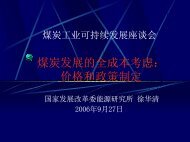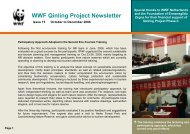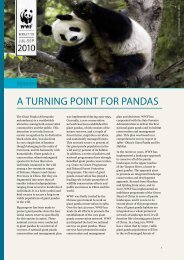Species
Species
Species
You also want an ePaper? Increase the reach of your titles
YUMPU automatically turns print PDFs into web optimized ePapers that Google loves.
Xxxx xxxxx<br />
During the 4 days training, 3 guest<br />
speakers, respectively from Peking<br />
University, Shaanxi Institute of<br />
Zoology and Changqing National<br />
Nature Reserve, have demonstrated<br />
the great advantages of camera<br />
trapping in wildlife research and<br />
conservation, as well as their<br />
personal knowledge and experience<br />
on applications and placement<br />
techniques.<br />
Wang Fang, doctor of philosophy<br />
in zoology from Peking University,<br />
one of the guest speakers.<br />
From varieties of his research<br />
experiences on many large-bodied<br />
animals, he believes that camera<br />
trapping is a very helpful tool in<br />
wildlife research and conservation.<br />
He stressed that camera traps are<br />
not only about pictures. They are<br />
very useful observation method,<br />
which provide objective and<br />
accurate data can be viewed by<br />
many people. From his research<br />
experiences in western China,<br />
he concluded that its research<br />
applications may include the<br />
detection of new or rare species,<br />
estimation of population size and<br />
richness, determining animal<br />
behavioral, activity rhythm and<br />
migration patterns. In fact, there<br />
are more questions that have yet<br />
to be known; he added; however,<br />
answering these questions may<br />
not only require money and time<br />
investment, but more collaboration<br />
efforts on sharing knowledge and<br />
skills. He is glad to see that WWF<br />
has been working on both.<br />
Zhang Ximing, from Changqing<br />
national nature reserve, with rich<br />
experience of using camera traps.<br />
He believes that camera trapping<br />
is not only efficient on detection<br />
of rare and new species, it is also a<br />
cost effective tool for conservation<br />
and communication. It can be<br />
very helpful for biodiversity<br />
conservation and management<br />
at policy level; also, it improves<br />
people’s capacities and skills at<br />
the frontline. Moreover, it is very<br />
helpful to enrich public’s knowledge<br />
on nature conservation and<br />
animals; raise one’s awareness on<br />
biological conservation importance.<br />
He pointed out, although camera<br />
traps are a great monitoring<br />
tool, it is only a supplement. The<br />
identification of no presence of one<br />
animal does not necessarily mean<br />
its inexistence. He said, sometimes,<br />
the reason for capturing no<br />
valuable data varies from many<br />
reasons. It can be the site selection,<br />
sensor and camera equipment, or<br />
the weather conditions.<br />
Wu Xiaomin, senior researcher<br />
from Shaanxi Institute of Zoology,<br />
he believes that camera traps<br />
are cost effective tools for many<br />
long-term monitoring researches<br />
and observations. They work 24<br />
hours 7 days, around the clock; and<br />
they can collect a large amount of<br />
accurate data and information for<br />
researches.<br />
In his presentation, he had shown<br />
us many of his participated<br />
researches with using camera<br />
trapping method, including 1)<br />
observation researches on wildlife<br />
crossings along the famous<br />
Qinghai-Tibet Railway (impact<br />
observation researches and studies<br />
on migration of Tibetan antelope<br />
and other wild animals in the area),<br />
2) joint researches with WWF on<br />
Qinling giant panda corridor use<br />
over 108 road Qinling tunnel, and<br />
3) the latest biodiversity baseline<br />
surveys on Xi’an-Chengdu high<br />
speed railway construction.<br />
Mr Wang Fang (Up), Zhang Ximing (Middle), and Wu Xiaomin (Low). © WWF/Hao Liang.<br />
2














